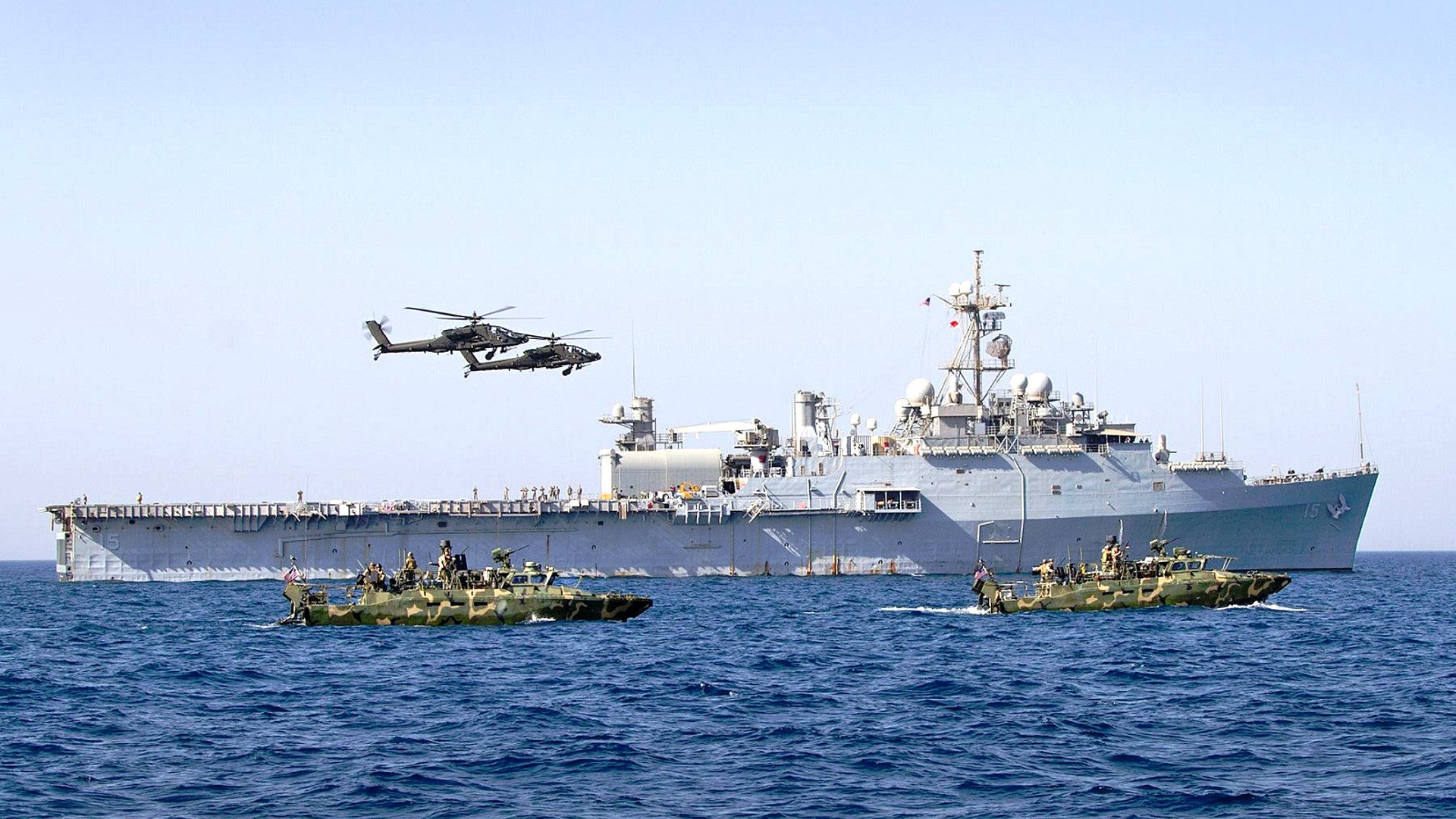One of the U.S. Navy’s most unique ships, the USS Ponce, has returned home to the United States after spending more than five years as a floating base in and around the Arabian Sea. Though she was the subject of intense public interest during that time, thanks to internal histories The War Zone obtained through the Freedom of Information Act, we can tell the story of a ship that went from being infested with bugs and headed to the scrap heap to a hub for conventional and special operations elements in the Middle East that helped set the stage for an all-new classes of ships.
On Sept. 27, 2017, Ponce, also known by the nickname “the Proud Lion,” sailed back into Norfolk Naval Station in Virginia after her extended tour of duty in the Middle East attached to the U.S. Fifth Fleet, where she acted as a crisis response command center, ready to assist with a wide array of missions, including mine sweeping, hunting pirates and terrorists, and general maritime security and humanitarian relief. The Navy plans to formally remove her from the rolls next month and beginning breaking her apart by the end of the year.
“The U.S. Navy’s ‘Proud Lion’ is America’s proof of concept of innovative warfighting operations and a testament to unmatched professionalism,” U.S. Marine Corps Brigadier General Francis Donovan, the commander of the 5th Marine Expeditionary Brigade, told the ship’s combined crew of Navy sailors and civilian merchant mariners after their return. “It’s simply not possible to recount the extraordinary things Ponce has accomplished in her 46 years of service, but it is sufficient to say that the durability, flexibility and clarity of design inherent in Ponce will be missed. This is well-reflected by the fact that Ponce has outlived whole classes of ships that were commissioned when Ponce was already 10 years old.”
Donovan’s remarks might sound a little like canned praise, the kind of which could accompany the end of any mission overseas, but it’s hard to overstate the significance of Ponce. In 2012, she was just one of just two Austin-class landing platform docks, an amphibious operations ship displacing more than 16,500 tons with a full crew and load of Marines and their equipment, still in service.
In service since 1971, she was already destined for the scrap yard. Instead, in 2011, in something of a surprise decision, the Navy changed course and refitted her for new mission as a dedicated forward base in a part of the world were facilities on land might be vulnerable to attack or otherwise difficult to maintain.
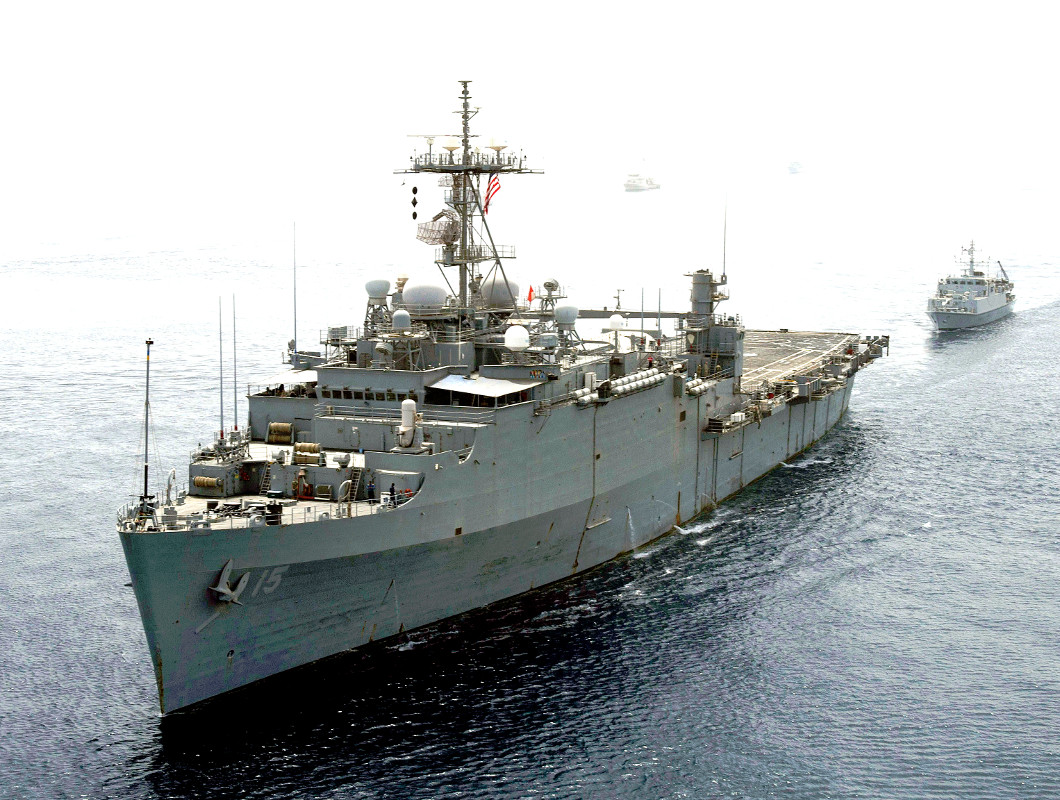
A note on a napkin
In December 2011, a number of senior naval officials, including the service’s then top uniformed officer, Chief of Naval Operations Admiral Gary Roughead, officers gathered at Naval Air Station Pensacola in Florida for the annual Aviation Flag Officers’ Symposium. Also in attendance were Admiral John Harvey, head of U.S. Fleet Forces Command, and Rear Admiral Mark Buzby, in charge of Military Sealift Command.
Though the topics of the day were primarily centered on naval aviation issues, Harvey had something else pressing on his mind. Some 10 months earlier, U.S. Marine Corps General James Mattis, then head of U.S. Central Command, the top headquarters for American military operations in much of the Middle East and Central Asia, had written an urgent request for some form of afloat forward staging base that could support the myriad ongoing operations along the Arabian Sea, the Persian Gulf, and the Gulf of Aden.
So, on the sidelines of the symposium, Harvey slipped Buzby a handwritten note on a napkin asking if it would be possible to save Ponce from retirement and use the ship to meet Mattis’ needs, according to one of three Command Operations Reports for the ship’s official internal histories, which we got through FOIA. “Buzby nodded affirmative from a distance,” the annual review noted.

Mattis would likely have been well aware of the capabilities of such a ship. As a colonel nearly a decade earlier, he had commanded Task Force 58 in southern Afghanistan, the first Marine officer to head a Navy task force. As part of that planning process in 2001, and surely as he ascended the ranks thereafter, he would have learned that the aircraft carrier USS Kitty Hawk had acted as an impromptu staging area for special operations elements, including helicopters from the U.S. Army’s 160th Special Operations Aviation Regiment (SOAR), the “Nightstalkers,” in the initial stages of the American intervention against Al Qaeda and their Taliban allies.
The Navy’s official news story about Ponce’s arrival at Norfolk says the experience with Kitty Hawk directly led to the decision to reconfigure the amphibious ship specifically for such a role. However, the amphibious ship was smaller, lacked the carrier’s large flight deck and other support facilities, and was configured more as an assault transport than anything else, focused on bringing Marines and their gear to an area and get them ashore.
Not to mention, the Austin-class vessel was simply old, in increasing disrepair, and many of its basic systems were obsolete. Oh, and it was filthy.
“When the crew arrived, it was estimated by the industrial hygiene team that an 850,000 [member] roach colony had inhabited Ponce,” one of the histories said. “Intense cleaning, persistent pest control and maintenance provided a shipboard environment fitting for the hardworking crew!”
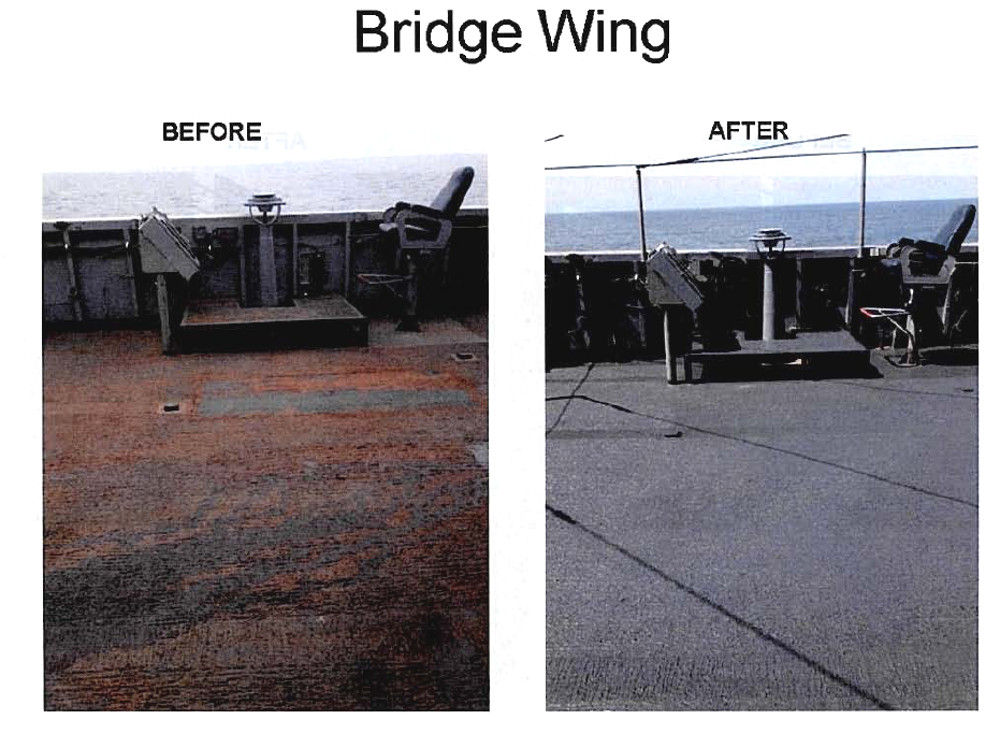
Already slated for decommissioning, the Navy found it could not allocate funds for a full technology refresh either, and had to rebuild and refurbish computer system and other equipment. Personnel had to scour warehouses and work with the Defense Logistics Agency’s Defense Reutilization and Marketing Office, which deals in excess and surplus gear, to find the parts they needed to get everything working properly.
“Fleet Forces Command, Military Sealift Command, Surface Forces Atlantic and Command Strike Force Training Atlantic invested a lot of time and resources in getting the ship upgraded with state-of-the-art equipment,” one of the histories explained. And they did it fast, having the newly refitted ship, reclassified as an Interim Afloat Forward Staging Base, out for sea trials within a month.
The new Ponce retained a number of features from its original configuration, including the well deck and portions of her cargo space and accommodations for personnel temporarily embarked on board. Her defenses remained limited to a pair of Phalanx Close In Weapon System turrets with 20mm Vulcan cannons, another two 25mm automatic guns, and a number of .50 caliber machine guns and other small arms.
She continued to have her fairly large flight deck at the rear, able to accommodate large helicopters, including the Navy’s MH-53E Sea Dragon mine hunters and the Army’s CH-47 Chinook transports. She had no manned aircraft permanently on board, but carried a compliment of small Scan Eagle drones to provide additional situation awareness over the water or even on land if she got close enough to shore. This was the first time the Navy had deployed Scan Eagle on a ship and in 2013, the unmanned aircraft flew more than 1,500 hours of surveillance missions, a U.S. Fifth Fleet public affairs officer told me in an Email in 2014.
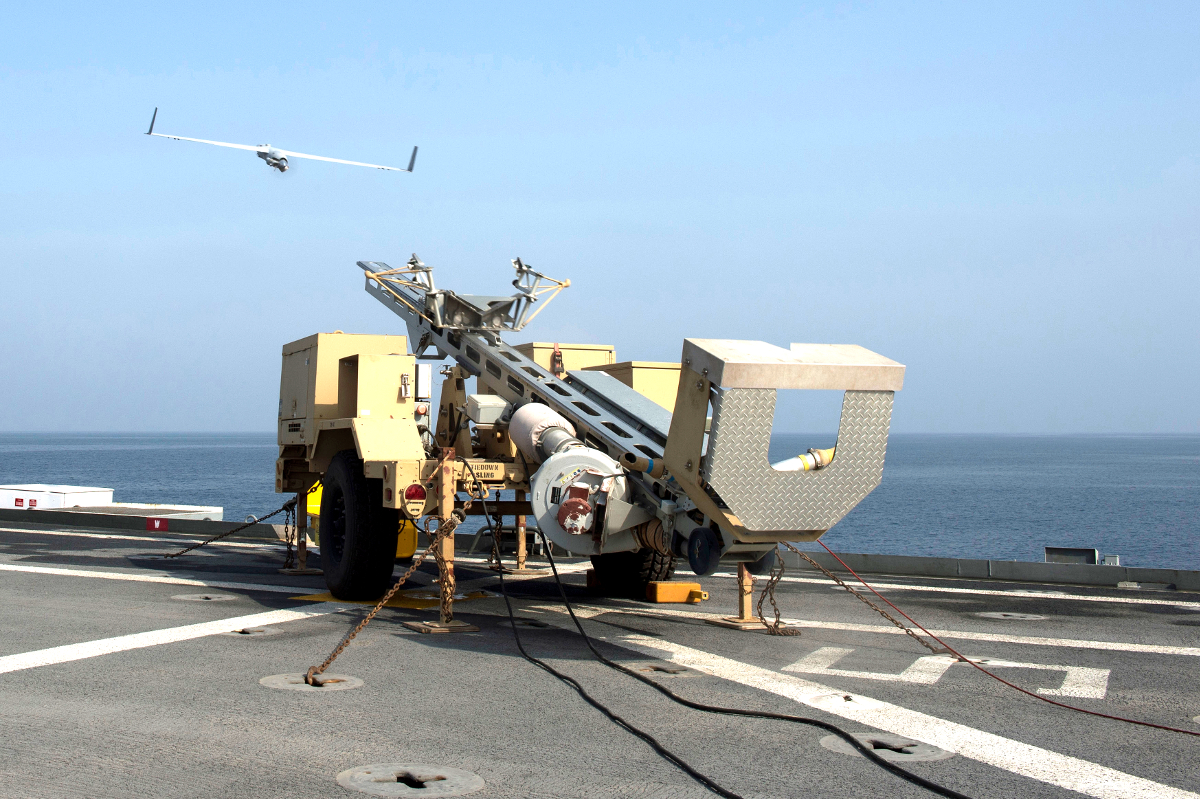
But the Navy added in a full suite of repair facilities so the crew could maintain an array of mine sweeping gear, special operations equipment, and even support operations with allied forces. More importantly, Ponce gained eight all-new “mission spaces,” command centers with video conference capability and more than 130 computer work stations. A larger central joint operations center was connected by satellite to six military networks ranging from basic unclassified connections to the top secret Joint Worldwide Intelligence Communications System, or JWICS. On top of that the ship had the first ever “Internet Café at sea, greatly increasing crew morale and reduced the bandwidth burden on the ship’s network,” the U.S. Fifth Fleet spokesperson also told me that their 2014 Email.
A unique crew of 165 civilians from the quasi-miltiary Military Sealift Command and nearly 60 sailors, assigned to the ship as individual augmentees, manned the new sea base, more than 130 personnel less than the original full compliment for an Austin-class. This meant that the vessel had room from another 350 additional personnel to conduct specialized operations when necessary.
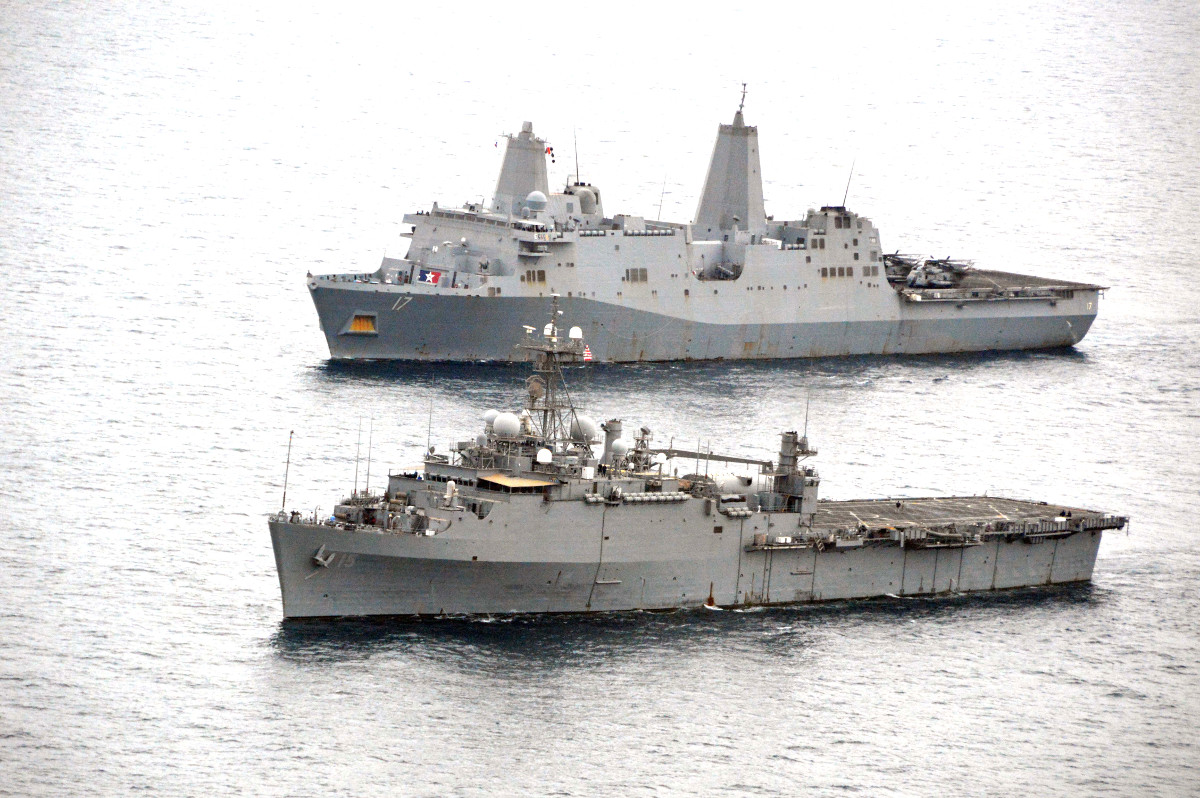
The idea of a floating base
Though Kitty Hawk may have provided an example of what Ponce could do in her new guise, the idea of a floating base was hardly new to the Navy in 2011. During World War II, it had become particularly apparent that air power had become essential to the American way of war, but that it would be hard to support aviation operations in some newly liberated areas, especially after amphibious operations far from main allied bases.
In 1944, as part of Operation Ivory Soap, the U.S. military converted six Liberty Ships and another 18 auxiliary freighters into a fleet of repair shops to support B-29 bombers and escorting fighters as American forces island hopped their way across the Pacific fighting the Japanese. A mixture of Army Air Forces and Merchant Marine personnel manned the repurposed fleet. There was already a certain knowledge base for these sorts operations from the Navy’s seaplane tenders.
The demands of expeditionary operations continued after the war ended. In 1957, the U.S. Navy turned the tank landing ship USS Alameda County into another dedicated aviation support vessel. The next year, she sailed into the Eastern Mediterranean to support Marine aviators taking part in the American intervention in Lebanon.
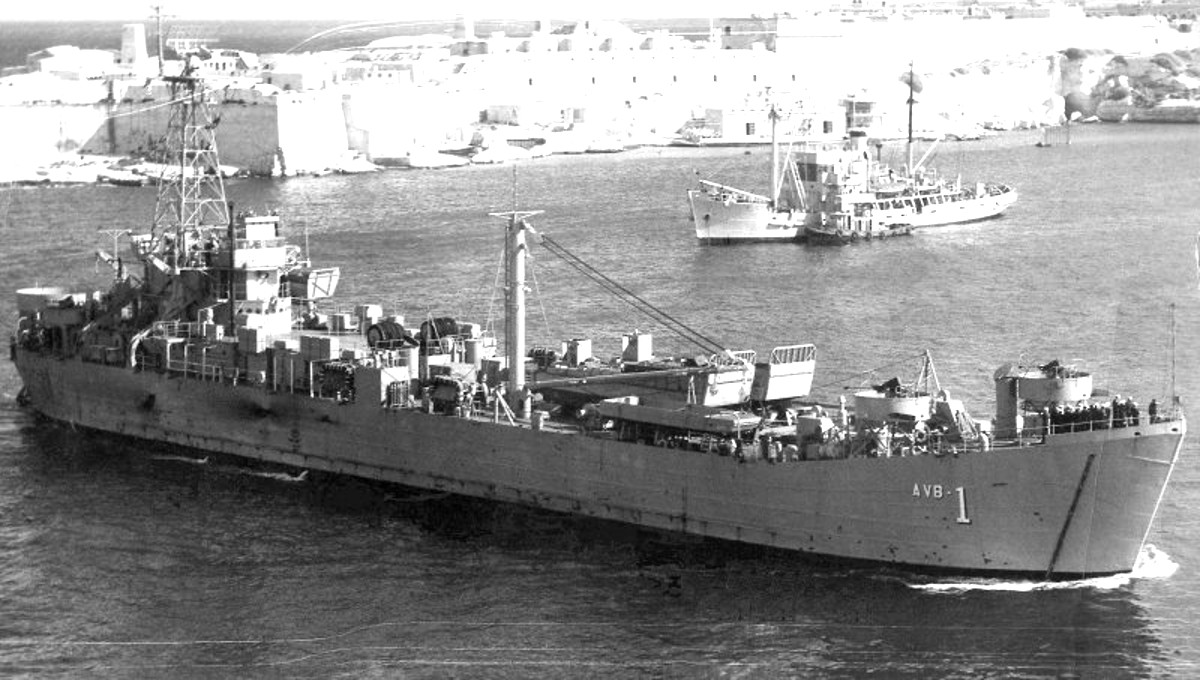
Larger and more capable amphibious ships, along with the growing importance of the helicopter, began to change the nature of these operations and reduced the need for separate aviation support ships to support fixed wing aircraft ashore during an assault. The USS Austin, which entered service in 1965, and her class of landing platform docks, was part of this transformation.
Ponce herself spent much of her history as an amphibious ship supporting expeditionary operations, including participating in the response to the 1983 bombing of the Marine Corps barracks in Beirut, the evacuation of American civilians and the reinforcement of the American embassy in Liberia in 1990, and the first Gulf War in 1991. Before formally becoming a sea base in 2012, the ship had stood ready for mine sweeping operations in the Persian Gulf during the 2000s on a rotational basis.
The idea of the dedicated sea base never went away though. During the Vietnam War, the Navy repurposed flying boat tenders, unpowered barracks barges, and other floating platforms to support both conventional and special operations elements on and above South Vietnam’s winding water ways. The bases of the “brown water navy” gave commanders additional flexibility and some additional protection compared to small outposts on land.
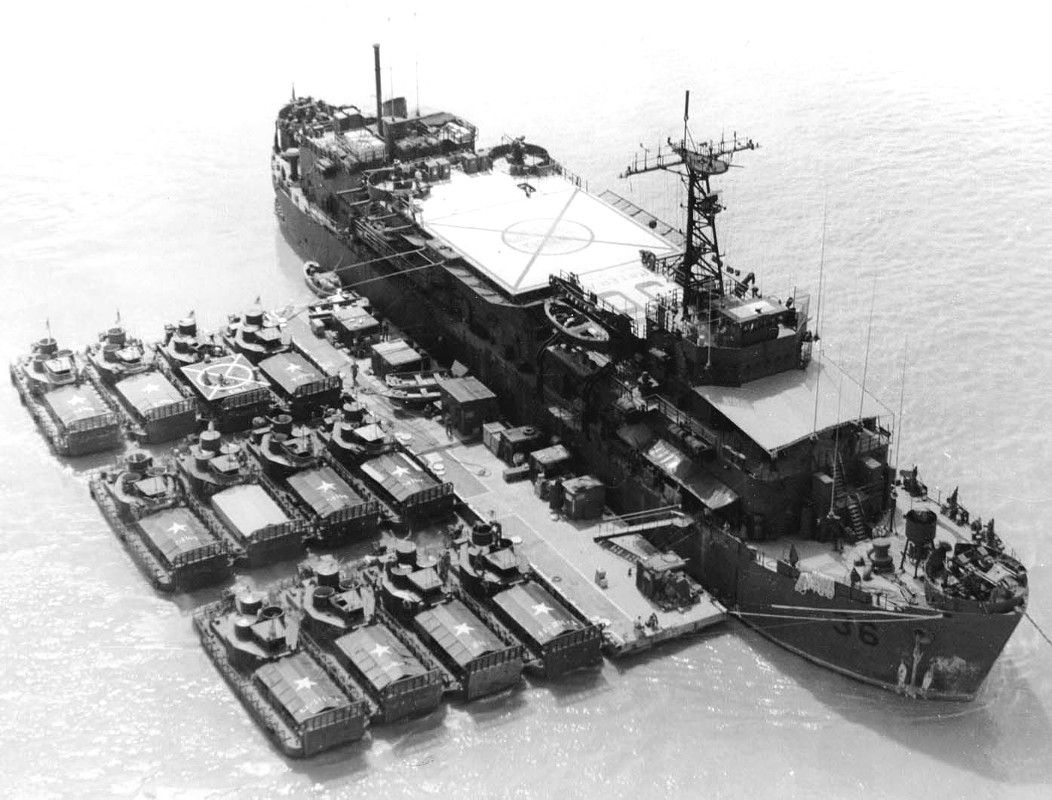
During the so-called “Tanker War” sideshow to the Iran-Iraq war during the 1980s, the U.S. military again established temporary floating facilities to support operations to protect international shipping in the Persian Gulf. Two leased oil support barges, the Hercules and Wimbrown, hosted conventional and special operations elements to attack Iranian fast-attack boats and mine layers, as well as neutralize any floating obstacles.
In particular, the platforms provided a landing pad for AH-6, MH-6, and MH-60 helicopters from the 160th SOAR. Conventional Army aviators eventually replaced that unit with then-new “AH-58” Kiowa Warrior armed scout helicopters. Cruisers, destroyers, and frigates coordinated additional escort activities with these forward deployed forces.
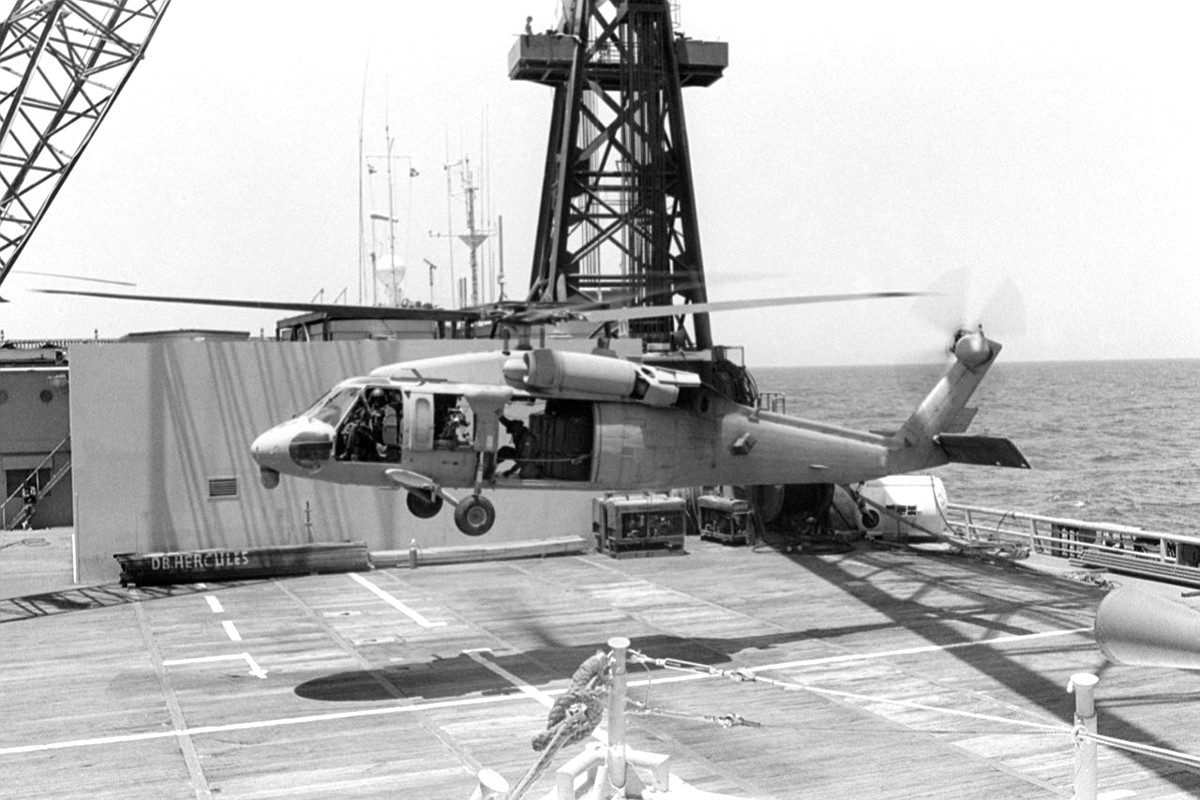
As already noted, after the 9/11 terrorist attacks, Kitty Hawk helped provide a base of operations for some of the early special operations elements moving into Afghanistan. Other aircraft carriers had taken up the role as a staging base for joint operations before then, too.
When the U.S. military intervened in Haiti in 1994 to upend a military junta that had taken control of the island three years earlier, USS Dwight D. Eisenhower and the USS America turned their deck space over to Army aviators and special operations forces, including members of both the 10th Mountain Division and the the 160th SOAR. Eisenhower alone carried nearly 60 helicopters, a mix of AH-1 Cobra gunships, OH-58 Kiowas, and UH-60 Black Hawk and CH-47 Chinook transports.
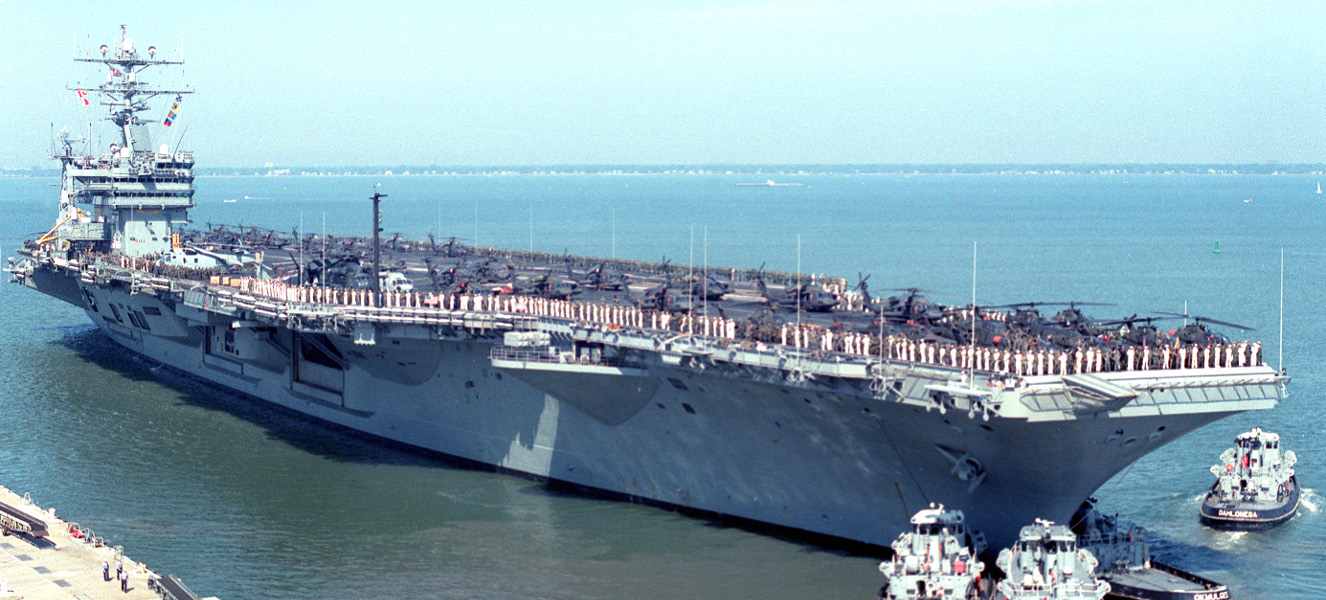
Ponce goes to the Middle East
On July 6, 2012, Ponce arrived in Manama, Bahrain, home to the U.S. Fifth Fleet headquarters, to take up her new post in the region. In line with her main job as a base for possible mine clearing operations, a long-standing U.S. military concern in the Persian Gulf given its past experiences with Iranian naval forces, the crew of the sea base had already begun training with MH-53Es from Helicopter Mine Countermeasures Squadron 15 (HM-15) before it even reached the port.
That year, and every year through 2016, Ponce was a major player in the annual massive multinational International Mine Countermeasures Exercise (IMCMEX) in the Persian Gulf. More than 4,000 personnel from more than 30 different countries aboard more than 30 ships made the 2016 iteration one of the largest naval drills in the world ever.
Ponce became a test bed for various new anti-mine technologies, including unmanned underwater vehicles. She also famously became the first ship to feature an operational laser weapon, which was able to attack targets both on the surface and in the air.

And though she was never called upon to perform the mission during an actual crisis, mine sweeping became the major public face of Ponce’s activities in the region. However, her operations were significantly more varied right from the beginning.
The internal histories notes, though, that the first thing she did upon entering the Persian Gulf on July 1, 2012, was host aviators from the United Arab Emirates Air Force’s Group 18, the helicopter element attached to that country’s special operations command. The reports don’t say which types of helicopters qualified to land aboard point, but the unit had UH-60M Black Hawk and CH-47 Chinook transports, as well as AH-64 Apache gunships, at the time, among other types.

In August 2012, a pair of U.S. Army Apaches touched down for deck qualifications and additional over-water training. Over the next five years, these drills would become a routine and important part of regular Army and Army National Guard deployments to Kuwait, which also often featured representatives from regional militaries, including both the Kuwaitis and the Emiratis. The Ponce’s galley staff provided a signature box lunch for every aviator who touched down on board, a document attached to one official history noted.
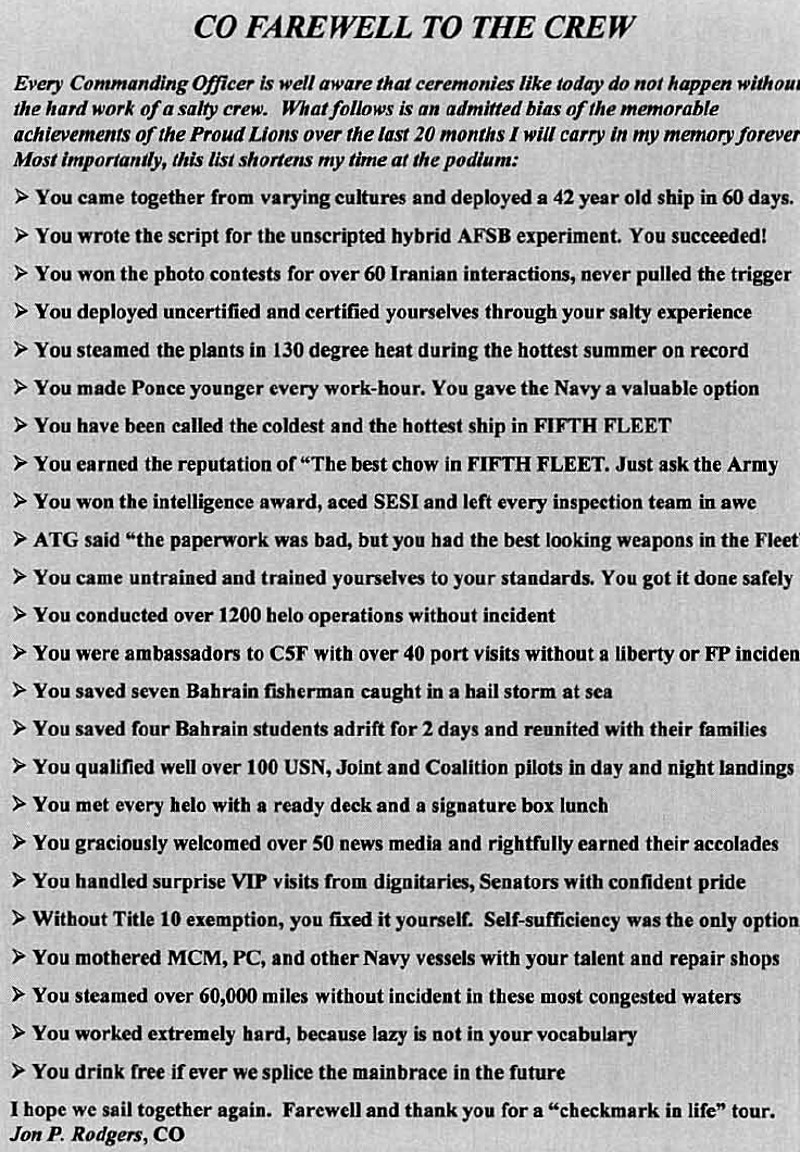
In December 2013, Ponce hosted Army AH-64s as one part of large joint exercise called Spartan Kopis. In addition to the Apaches, Navy and Coast Guard destroyers and patrol craft, together with embarked Marines and Air Force B-1 bombers, worked together to locate and destroy a variety of mock naval targets.
These exercises were especially important given the continuing propensity for the Iran’s Islamic Revolutionary Guard Corps to harass American military vessels in the region and the potential for a larger crisis. In 2013, Ponce alone had more than 60 interactions with Iranian naval forces and “never pulled the trigger,” according to one historical review.

The possibility of a crisis erupting became particularly apparent in January 2016 when Iran captured 10 sailors and two Riverine Command Boats, touching off a major international incident. Ponce had been involved in the operations of these craft, often acting as a mothership, for more than two years by that point, supporting counter-piracy and basic maritime security efforts, sometimes stopping to rescue civilian fishermen after accidents or mechanical breakdowns. The sea base also “mothered” Avenger-class mine clearing ships, Cyclone-class patrol craft, and various secretive special operations boats.
Special operations were a major component of Ponce’s routine activities. Beginning in Sept. 2012, she trained regularly with the standing special operations crisis response element in the region, as well as other elite elements, including Navy SEALs and special boat units.
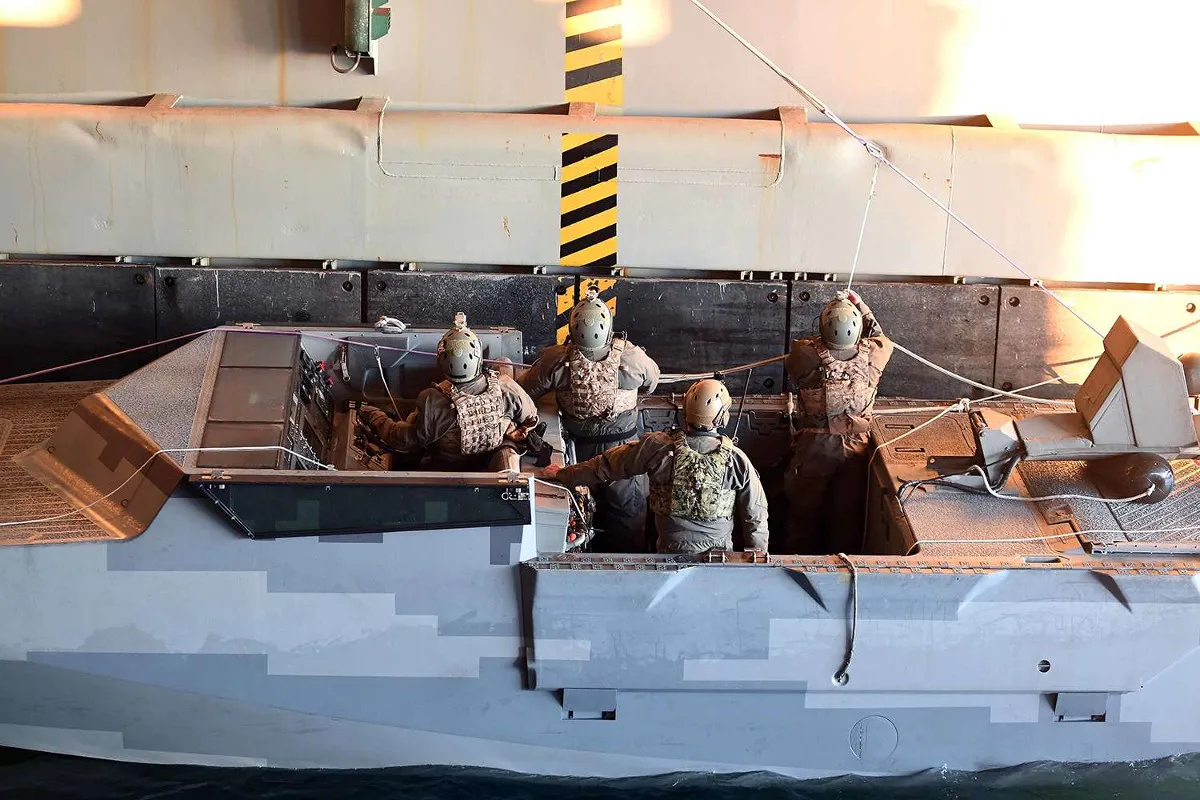
As ISIS terrorists surged into Iraq in 2014, the sea base repositioned into the northern end of the Persian Gulf to join the American response to the growing crisis. We don’t know exactly what the vessel did specifically, but that year she worked with Marine Corps MV-22 Ospreys from the Marine Expeditionary Unit assigned to the amphibious assault ship USS Bataan and the rest of her Amphibious Ready Group.
Those tilt-rotor aircraft support a number of special operations activities during their time in the region, including the survey of the situation on top of Mount Sinjar in late 2014. Members of Iraq’s Yazidi religious minority had fled there to escape death, torture, and rape at the hands of ISIS, but found themselves trapped and without food and water. Ultimately, the United States opted to rush in humanitarian relief rather than attempt to evacuate the thousands of people who had gathered on the mountain.
Ponce continued to be active throughout the region. In October 2016, the sea base came under direct threat from Iranian-supported Houthi rebels in Yemen, who fired anti-ship missiles at her and the USS Mason, an Arleigh Burke-class destroy that had been acting as an escort. She had moved into the area as part of a larger response to earlier attacks on American and other foreign vessels.
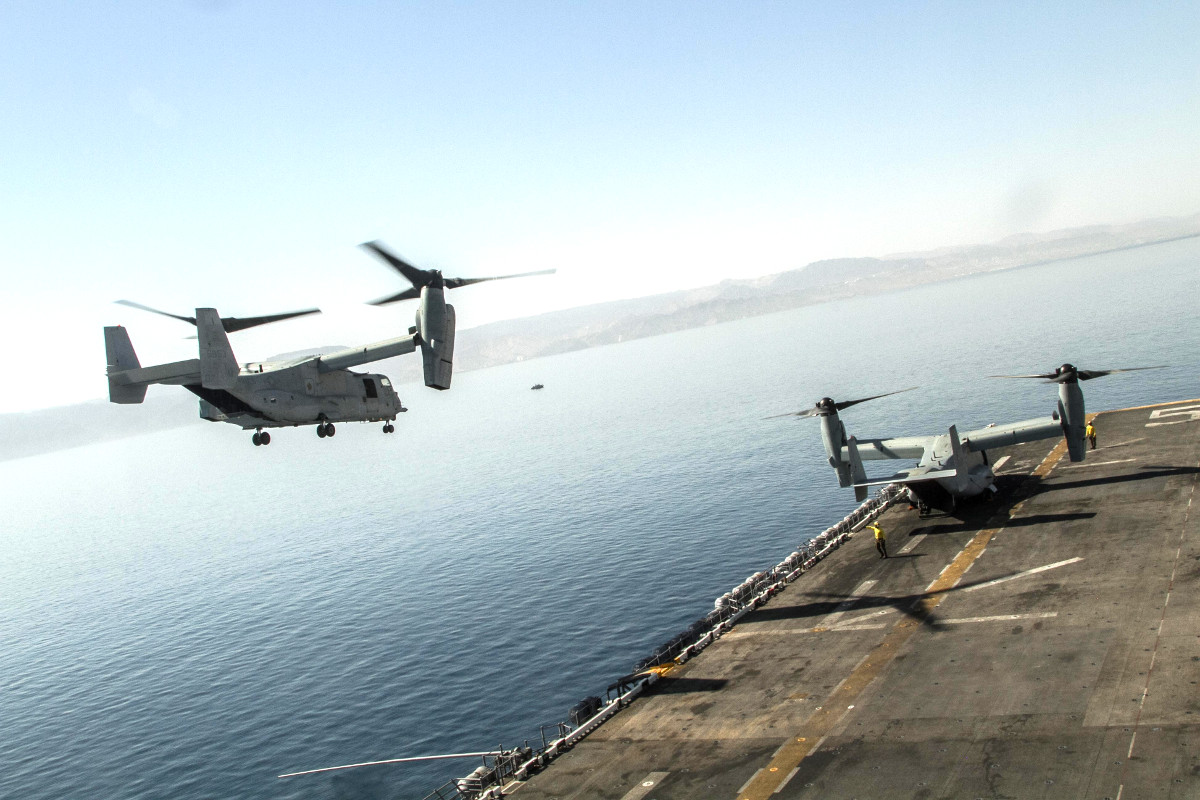
The future of sea basing
Though Ponce now appears truly destined for retirement, she definitely helped set the stage for the service’s operations for the foreseeable future. As Ponce was proving her worth in the Middle East, a new class of sea bases took shape.
On June 10, 2017, the USS Lewis B. “Chesty” Puller, left Norfolk to pick up where the “interim” sea base had left off. Classified as an Expeditionary Mobile Base, Puller is a highly modified oil tanker specifically configured to support the same wide variety of missions. Originally part of Military Sealift Command, the ship has become attached to U.S. Fifth Fleet. The War Zone’s own Tyler Rogoway has written a deep profile of this new ship, which you can find here.
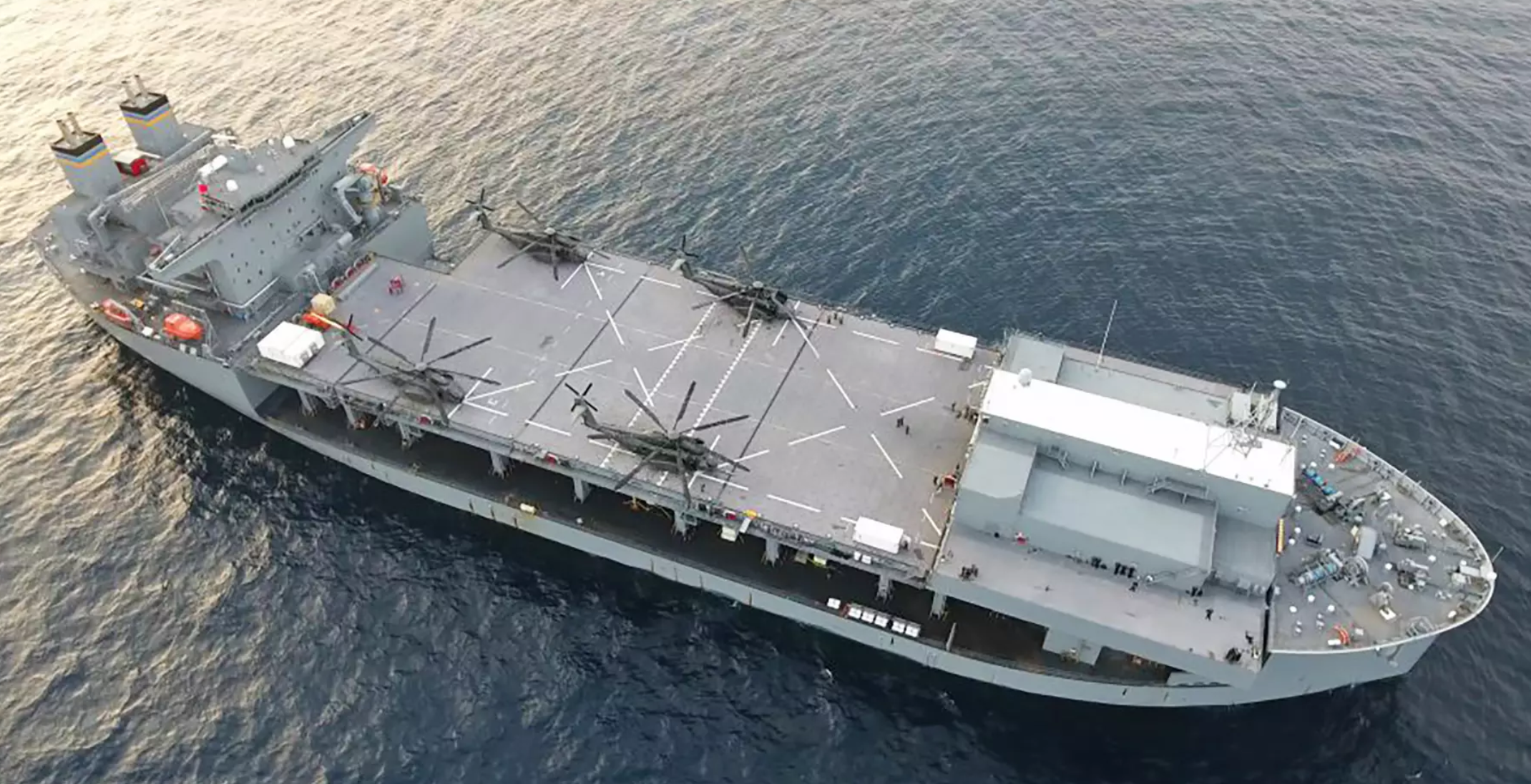
Suffice to say, sea basing is here to stay, enshrined in the U.S. Navy’s understanding of how it will fight wars and respond to other crises for the foreseeable future. There is even the possibility that these ships might become capable of rapidly turning into floating fire bases if necessary.
Both the Army and the Marine Corps are already interested in the possibility of firing guided artillery rockets from the decks of ships, using the truck-mounted High Mobility Artillery Rocket System (HIMARS). Both services are looking at expanding the utility of these systems with new long-range ballistic and anti-ship missiles.
A 2016 document describing future concepts for Marine Corps wargaming scenarios suggests that it could also install these systems on unpowered barges and other floating platforms to provide additional fire support. One idea, dubbed “Box O’Rockets,” would involve a containerized launcher for rockets, cruise missiles, and other guided munitions that would fit easily on almost any platform, mobile or otherwise.
“If the enemy has a capability to shoot my large ship or my destroyer or my carrier from a couple hundred nautical miles away – or maybe longer – I’ve got to do something about that,” Marine Corps Commandant General Robert Neller said at the Marine Corps League’s annual Modern Day Marine exposition on Sept. 20, 2017. “That’s why it’s important that all of these ships have the capability to do some sort of strike or denial – or some way to suppress that capability.”
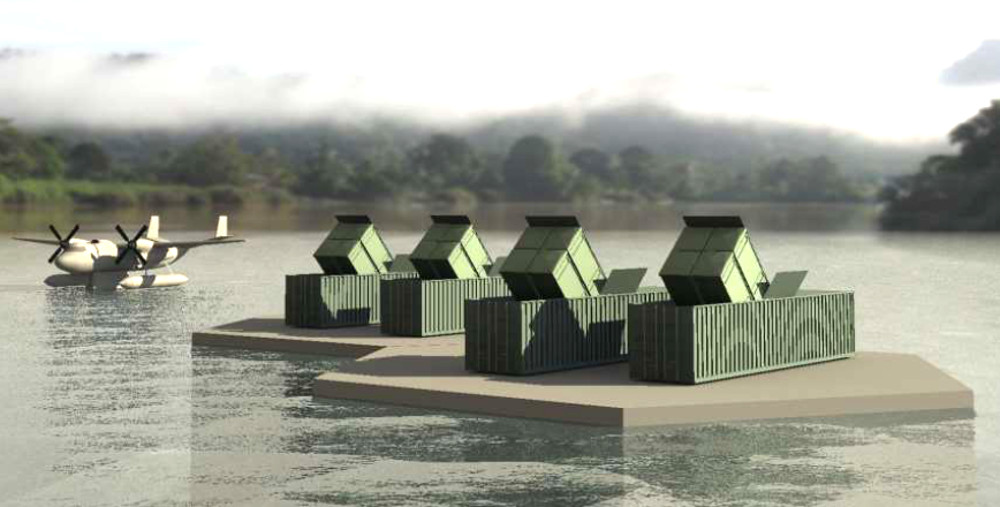
Special operations forces have also taken notice. Though we haven’t heard anything about it lately, U.S. Special Operations Command has been working to turn the M/V Cragside, a sleek-looking roll-on/roll-off cargo ship, into its own dedicated floating hub. This “Maritime Support Vessel” is slated to become part of Military Sealift Command.
Modularity and flexibility have always been at the very core of the basic sea base idea. It’s unlikely we’ve seen everything these types of ships have to offer.
There’s a slim possibility Ponce might survive the scrap yard once again. Earlier in September 2017, unconfirmed reports appeared suggesting that Argentina might be interested in acquiring the old ship. Depending on how much the U.S. Navy strips away, the Argentinian Navy could face the prospect of having to invest a significant amount in reactivating the ship though.
What we do know is that the “Proud Lion” and its perhaps inauspicious origins as a floating base have played an outsized role in making this concept a signature component of the future U.S. Navy.
Contact the author: joe@thedrive.com
